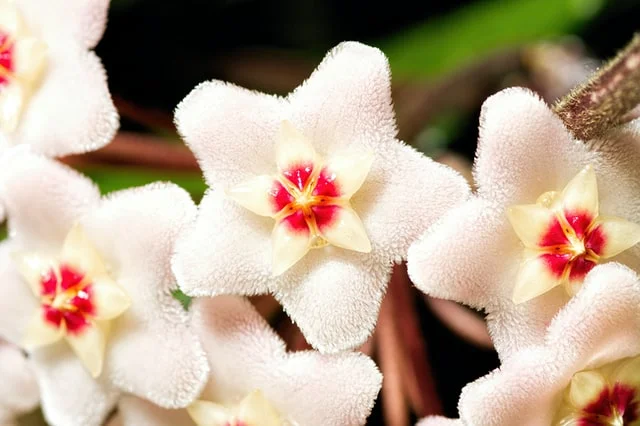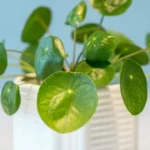Table of Contents
How to Care for a Hoya Obovata
The hoya obovata is a rare plant species native to Fiji, India, Indonesia, and Thailand. It is a creeping epiphyte and semi-succulent, which makes a great houseplant without many needs.
The hoya obovata has large, oval-shaped leaves that are deep green with flecks of pink and white. The leaves shoot out from long tendrils coming from the plant base.
Eventually, the long vines of the hoya obovata grow very long and develop clusters of sweet-smelling, pink star-shaped flowers.
As houseplants, the hoya obovata is often planted in hanging baskets to let the vines overflow. They also look quite beautiful growing on trellises, stakes, and window sills.
What does your hoya obovata require:
Hoya obovata are low maintenance plants. However, they still have basic needs, and when they are fulfilled, the plants can live to be quite healthy and vibrant.
Light requirements
Bright but indirect natural light is best for hoya obovata plants. Direct sunlight may damage the leaves, but low lighting can make the greenery wilt. East-facing light, whenever possible, is recommended.
Temperature requirements
Hoya obovata houseplants can tolerate a wide range of temperatures. However, they perform best when the air is between 15-29 degrees Celsius (60-85 degrees Fahrenheit.
Humidity requirements
Hoya obovata plants can tolerate the average household air humidity levels, but they grow best when the level is higher than 60%. A fine mist can be sprayed into the air, or an air humidifier may be used, for this purpose.
Soil requirements
The potting soil needs to retain moisture while also being well-drained and able to dry properly within a reasonable time. The suggested soil combinations contain peat along with fine orchid bark and perlite. Pumice may also be added to this mixture.
How to Water
Hoya obovata like moist air but not wet soil. Watering should only be done when the first inch of the soil’s surface is dry to the touch but before the soil is completely dry.
During the spring and summer months, watering is typically done more frequently than in the winter months, when the temperature is often slightly lower.
However, inside plants located where air temperatures are consistent may be tricked into not recognizing seasons as the plants placed outside. In such cases, the hoya obovata may require the same level of watering all year.
How to Fertilize
Hoya obovata plants can be fertilized throughout the year. However, most professionals agree that plant food is not needed during the winter when the hoya obovata is dormant.
When adding fertilizer to the soil, a half-dose of the liquid solution is recommended because the nutrients are easier to absorb, and the liquid can reach right down to the roots.
This type of plant food may be added once per month, excluding the winter months.
Small granules of dry fertilizer also work well for the hoya obovata if they are time-released. This form releases the nutrients into the soil slowly so that it doesn’t need to be added as often. In most cases, the food only has to be given every few months.
Whether the granule or liquid form of plant food is chosen, it must have a higher nitrogen content to keep the hoya obovata plant healthy and vigorous.
Extra Tips for a Hoya Obovata
As with anything, extra tips can go a long way when caring for hoya obovata plants. The tips below can help in dealing with pests and diseases, as well as pruning and propagation – all crucial aspects of having healthy houseplants.
Pests and Diseases
There are several pests and diseases that hoya obovata plants may have to deal with. Not overwatering and overfertilizing the hoya obovata can prevent some of these issues. If they do occur, they can almost always be treated when discovered fast enough.
Aphids
These are sap-sucking insects. These pests will leave a sticky residue on the stems after feeding, which is one sign of infestation.
Mealybugs
These are white or light pink segmented insects that leave a white wax or cotton-like substance wherever they settle.
Spider mites
These are small red, black, or white spiders that leave a dusty covering on the leaves.
Root rot
This causes discoloration and yellowing leaves in the hoya obovata.
Sooty mold
This is a black mold that forms on the leaves that often becomes sticky with sap. This issue may be caused by the sap itself or by aphids.
Natural or chemical insecticides and insecticidal soap are commonly used to treat issues with these pests. Methods may vary according to the type and severity of the infestation.
Fungal issues, such as root rot and sooty mold, usually require the hoya obovata to be repotted into fresh soil, ensuring that it is not overwatered or overfertilized. Fungicides might be required for further treatment.
New pots must be equipped with adequate drainage systems so that waterlogging does not occur.
Pruning
Hoya obovata houseplants can be pruned using sharp, sterilized pruning shears, scissors, or blades. To improve appearance, health, and growth, trimming off any dead, damaged, or wilted foliage is recommended.
Any areas that appear to be diseased should be removed also. The same may be done to long or stringy pieces of growth so that the plant will look more compact and neat. Older dying blooms can be cut also, as this often encourages newer flowers to grow.
Pruning the hoya obovata is typically simple. However, it is vital not to remove more than two-thirds of its total growth. This action can stunt additional development.
Propagation
Propagating hoya obovata plants is usually done in the spring or summer using cuttings. Each snippet should be between four and five inches 10-13cm) long with at least two leaves attached, not including any lower leaves close to the cut.
Leaves close to the cut on the stem should be removed. Cuttings may be dipped in rooting hormone before being planted in a well-drained but moist potting mix that contains sand, perlite, or vermiculite.
The soil needs to be kept moist but must not be overwatered to prevent the hoya obovata cuttings from developing rot.
Toxicity
The hoya obovata is non-toxic to humans and animals
Photo by Claud Richmond on Unsplash


